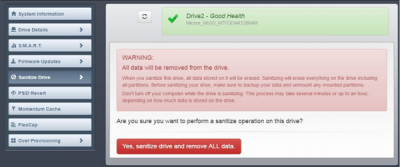

- #CRUCIAL STORAGE EXECUTIVE SANITIZE DRIVE UPDATE#
- #CRUCIAL STORAGE EXECUTIVE SANITIZE DRIVE SOFTWARE#
The SANITIZE OPERATION START EXT- BLOCK ERASE shall only be reported as supported if the internal media supports Block Erase operations (e.g. The SANITIZE BLOCK ERASE operation shall also remove user data held in caches and pin setting attributes (see 4.16). SANITIZE BLOCK ERASE The SANITIZE OPERATION START EXT - BLOCK ERASE command shall start a sanitize operation which shall cause Block Erase operations on all user data. While this drive supports SANITIZE CRYPTOGRAPHIC SCRAMBLE and SANITIZE OVERWRITE: hdparm -I /dev/sdx. This drive supports SANITIZE BLOCK ERASE: hdparm -I /dev/sdx. Last Sanitize Operation Completed Without ErrorĪn unsupported drive: hdparm -sanitize-status /dev/sdx Check for SANITIZE supportĪ supported drive: hdparm -sanitize-status /dev/sdx After you erase the drive using Secure Erase or Sanitize, all user data will be permanently destroyed on the selected drive. Therefore, Secure Erase is faster to complete than Sanitize. Sanitize will delete the mapping table and will erase all blocks that have been written to. This is preferred over the SECURITY ERASE UNIT command since SANITIZE is supported in both the T10 standard (SCSI) and the T13 standard (ATA), and for all derived busses.įinally, SanDisk states: Secure Erase is different from Sanitize because it only deletes the mapping table but will not erase all blocks that have been written to. Microsoft concurs: For new applications, it is recommended to use the CRYPTO SCRAMBLE EXT command from the SANITIZE feature set. IntroductionĪccording to NIST, The ATA Sanitize Device feature set commands are preferred over the ATA Security feature set SECURITY ERASE UNIT command when supported by the ATA device. These procedures will irretrievably destroy data.

See also NVMe Secure Erase and NVMe Sanitize in this series.) 0. (Note: This is a follow-up to ATA Secure Erase (SE) and hdparm, which includes suggestions for working around frozen drives and more. It is turned off by default, but you can turn it and use between 1-50% of the drives capacity for over-provisioning.ATA Sanitize and hdparm / docs / ATA Sanitize and hdparm If you are worried about your drives endurance and have room to spare you’ll want to enable over-provisioning in Crucial Storage Executive. Some insane numbers, but keep in mind that this is mostly the DRAM here and changing the memory frequency will drastically change these numbers. We did a quick test with Crucial Momentum Cache enabled on a secondary drive and found that our 4K read performance went from 31 MB/s to 664 MB/s and our sequential read speed went from 434 MB/s to 6,068 MB/s. Once the system comes back on you should see faster performance straight away if you enabled on on your primary C: drive. To enable Momentum Cache you just need to click one button in Storage Executive and then follow the prompts to restart the system. This increased the storage systems burst speed by up to 10x and helps reduce wear on the 3D TLC NAND Flash as the random data is being written to the DRAM instead. This is because Crucial Momentum Cache allows enhanced drive performance by allowing your systems DRAM to bugger random data writes instead of writing them to the the SSD. The Crucial MX300 ships with Momdemtum Cache disabled and we don’t advise enabling it unless you do daily backups and have a battery backup for your system. It also allows you to sanitize the drive (secure erase), setup encryption, enable Momentum Cache and change the drives Over Provisioning settings.
#CRUCIAL STORAGE EXECUTIVE SANITIZE DRIVE UPDATE#
This free download ensures you are getting the most out of your MX300 series SSD by allowing you to monitor your SSD performance, health, temperature, see how much space is used and update the firmware.
#CRUCIAL STORAGE EXECUTIVE SANITIZE DRIVE SOFTWARE#
On of the best things about the Crucial MX300 series is that you can download Crucial Storage Executive software application.


 0 kommentar(er)
0 kommentar(er)
